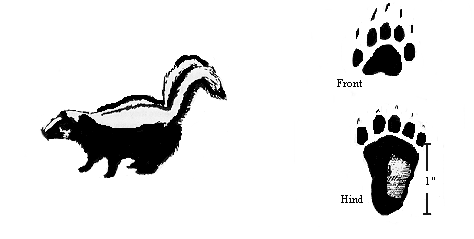

DISTRIBUTION: Common throughout North Dakota.
HABITAT: Found in almost every type of habitat in the state. Prefer marshes, grasslands, and brush areas. LIFE HISTORY: Skunks breed in February or March and have a gestation period of 63 days. The young are born in April or May and the average litter contains about six young with litters ranging from two to ten. Young skunks remain in the nest from six to seven weeks before they start accompanying their parents. They stay with their parents until fall. Occasionally a family will den up together in the winter.
Adult skunks weigh up to ten pounds although generally they weigh between six and eight pounds. Skunks are active both day and night and seem to be most active during the late evening and early hours of the night. They den up in groups during the winter. It is not too unusual to see them out for brief periods on warm winter days. This is especially true of some of the adult males.
The skunk has few natural enemies due to its well known defense. However, they are very susceptible to a host of diseases including rabies. These diseases strike the hardest when the skunk population is high and can drastically reduce the population in a very short period of time.
FOOD HABITS: Insects, small animals, birds, eggs, poultry, worms, berries, grubs, grasshoppers, and carrion are some of the more common foods of the skunk.
SUGGESTED BAITS: Meat scraps, fish, poultry offal and feathers, animal carcasses such as rabbit, muskrats, ground squirrels, skunks, etc. Meat used for skunk bait need not be fresh.
Many skunks are taken in dirt hole sets made for foxes as well as in blind and bait sets made for other species. Catching a skunk in a trap set for other species does not spoil the set; in fact, the skunk odor seems to make the set more attractive to other furbearers. Just remove the skunk and reset the trap.
Skunks are readily trapped near their den sites. They usually dig their own dens, often in brush and heavily grassed areas, and a den site will often be used year after year. An active den can be located by the presence of numerous small trails in the vicinity of the den, by the faint odor present, and by the general appearance on the den. Conceal your trap in one of the entrances to such a den and cover it lightly. Place the trap far enough away from the den so that you will not be faced with the problem of having to drag the trapped skunk out of the den.